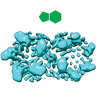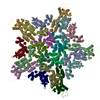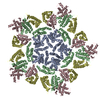[English] 日本語
 Yorodumi
Yorodumi- EMDB-12491: Structure of the mature RSV CA lattice: Group I, pentamer-hexamer... -
+ Open data
Open data
- Basic information
Basic information
| Entry | Database: EMDB / ID: EMD-12491 | ||||||||||||||||||
|---|---|---|---|---|---|---|---|---|---|---|---|---|---|---|---|---|---|---|---|
| Title | Structure of the mature RSV CA lattice: Group I, pentamer-hexamer interface, class 1 | ||||||||||||||||||
 Map data Map data | RSV CA lattice: pentamer-hexamer, class 1" | ||||||||||||||||||
 Sample Sample |
| ||||||||||||||||||
 Keywords Keywords | Retrovirus / Rous sarcoma virus / capsid protein / IP6 / VIRAL PROTEIN | ||||||||||||||||||
| Function / homology |  Function and homology information Function and homology informationhost cell nucleoplasm / viral procapsid maturation / host cell nucleolus / Hydrolases; Acting on peptide bonds (peptidases); Aspartic endopeptidases / viral capsid / structural constituent of virion / nucleic acid binding / aspartic-type endopeptidase activity / viral translational frameshifting / host cell plasma membrane ...host cell nucleoplasm / viral procapsid maturation / host cell nucleolus / Hydrolases; Acting on peptide bonds (peptidases); Aspartic endopeptidases / viral capsid / structural constituent of virion / nucleic acid binding / aspartic-type endopeptidase activity / viral translational frameshifting / host cell plasma membrane / proteolysis / zinc ion binding / membrane Similarity search - Function | ||||||||||||||||||
| Biological species |  Rous sarcoma virus (strain Prague C) / Rous sarcoma virus (strain Prague C) /  Rous sarcoma virus - Prague C Rous sarcoma virus - Prague C | ||||||||||||||||||
| Method | subtomogram averaging / cryo EM / Resolution: 6.0 Å | ||||||||||||||||||
 Authors Authors | Obr M / Ricana CL | ||||||||||||||||||
| Funding support |  Austria, Austria,  United States, European Union, 5 items United States, European Union, 5 items
| ||||||||||||||||||
 Citation Citation |  Journal: Nat Commun / Year: 2021 Journal: Nat Commun / Year: 2021Title: Structure of the mature Rous sarcoma virus lattice reveals a role for IP6 in the formation of the capsid hexamer. Authors: Martin Obr / Clifton L Ricana / Nadia Nikulin / Jon-Philip R Feathers / Marco Klanschnig / Andreas Thader / Marc C Johnson / Volker M Vogt / Florian K M Schur / Robert A Dick /   Abstract: Inositol hexakisphosphate (IP6) is an assembly cofactor for HIV-1. We report here that IP6 is also used for assembly of Rous sarcoma virus (RSV), a retrovirus from a different genus. IP6 is ~100-fold ...Inositol hexakisphosphate (IP6) is an assembly cofactor for HIV-1. We report here that IP6 is also used for assembly of Rous sarcoma virus (RSV), a retrovirus from a different genus. IP6 is ~100-fold more potent at promoting RSV mature capsid protein (CA) assembly than observed for HIV-1 and removal of IP6 in cells reduces infectivity by 100-fold. Here, visualized by cryo-electron tomography and subtomogram averaging, mature capsid-like particles show an IP6-like density in the CA hexamer, coordinated by rings of six lysines and six arginines. Phosphate and IP6 have opposing effects on CA in vitro assembly, inducing formation of T = 1 icosahedrons and tubes, respectively, implying that phosphate promotes pentamer and IP6 hexamer formation. Subtomogram averaging and classification optimized for analysis of pleomorphic retrovirus particles reveal that the heterogeneity of mature RSV CA polyhedrons results from an unexpected, intrinsic CA hexamer flexibility. In contrast, the CA pentamer forms rigid units organizing the local architecture. These different features of hexamers and pentamers determine the structural mechanism to form CA polyhedrons of variable shape in mature RSV particles. | ||||||||||||||||||
| History |
|
- Structure visualization
Structure visualization
| Movie |
 Movie viewer Movie viewer |
|---|---|
| Structure viewer | EM map:  SurfView SurfView Molmil Molmil Jmol/JSmol Jmol/JSmol |
| Supplemental images |
- Downloads & links
Downloads & links
-EMDB archive
| Map data |  emd_12491.map.gz emd_12491.map.gz | 17.5 MB |  EMDB map data format EMDB map data format | |
|---|---|---|---|---|
| Header (meta data) |  emd-12491-v30.xml emd-12491-v30.xml emd-12491.xml emd-12491.xml | 17.2 KB 17.2 KB | Display Display |  EMDB header EMDB header |
| Images |  emd_12491.png emd_12491.png | 126.3 KB | ||
| Filedesc metadata |  emd-12491.cif.gz emd-12491.cif.gz | 6.9 KB | ||
| Archive directory |  http://ftp.pdbj.org/pub/emdb/structures/EMD-12491 http://ftp.pdbj.org/pub/emdb/structures/EMD-12491 ftp://ftp.pdbj.org/pub/emdb/structures/EMD-12491 ftp://ftp.pdbj.org/pub/emdb/structures/EMD-12491 | HTTPS FTP |
-Validation report
| Summary document |  emd_12491_validation.pdf.gz emd_12491_validation.pdf.gz | 466.4 KB | Display |  EMDB validaton report EMDB validaton report |
|---|---|---|---|---|
| Full document |  emd_12491_full_validation.pdf.gz emd_12491_full_validation.pdf.gz | 466 KB | Display | |
| Data in XML |  emd_12491_validation.xml.gz emd_12491_validation.xml.gz | 6.2 KB | Display | |
| Data in CIF |  emd_12491_validation.cif.gz emd_12491_validation.cif.gz | 7 KB | Display | |
| Arichive directory |  https://ftp.pdbj.org/pub/emdb/validation_reports/EMD-12491 https://ftp.pdbj.org/pub/emdb/validation_reports/EMD-12491 ftp://ftp.pdbj.org/pub/emdb/validation_reports/EMD-12491 ftp://ftp.pdbj.org/pub/emdb/validation_reports/EMD-12491 | HTTPS FTP |
-Related structure data
| Related structure data |  7no6MC  7no0C  7no1C  7no2C  7no3C  7no4C  7no5C  7no7C  7no8C  7no9C  7noaC  7nobC  7nocC  7nodC  7noeC  7nofC  7nogC  7nohC  7noiC  7nojC  7nokC  7nolC  7nomC  7nonC  7nooC  7nopC  7noqC M: atomic model generated by this map C: citing same article ( |
|---|---|
| Similar structure data |
- Links
Links
| EMDB pages |  EMDB (EBI/PDBe) / EMDB (EBI/PDBe) /  EMDataResource EMDataResource |
|---|
- Map
Map
| File |  Download / File: emd_12491.map.gz / Format: CCP4 / Size: 27 MB / Type: IMAGE STORED AS FLOATING POINT NUMBER (4 BYTES) Download / File: emd_12491.map.gz / Format: CCP4 / Size: 27 MB / Type: IMAGE STORED AS FLOATING POINT NUMBER (4 BYTES) | ||||||||||||||||||||||||||||||||||||||||||||||||||||||||||||
|---|---|---|---|---|---|---|---|---|---|---|---|---|---|---|---|---|---|---|---|---|---|---|---|---|---|---|---|---|---|---|---|---|---|---|---|---|---|---|---|---|---|---|---|---|---|---|---|---|---|---|---|---|---|---|---|---|---|---|---|---|---|
| Annotation | RSV CA lattice: pentamer-hexamer, class 1" | ||||||||||||||||||||||||||||||||||||||||||||||||||||||||||||
| Projections & slices | Image control
Images are generated by Spider. | ||||||||||||||||||||||||||||||||||||||||||||||||||||||||||||
| Voxel size | X=Y=Z: 1.3278 Å | ||||||||||||||||||||||||||||||||||||||||||||||||||||||||||||
| Density |
| ||||||||||||||||||||||||||||||||||||||||||||||||||||||||||||
| Symmetry | Space group: 1 | ||||||||||||||||||||||||||||||||||||||||||||||||||||||||||||
| Details | EMDB XML:
CCP4 map header:
| ||||||||||||||||||||||||||||||||||||||||||||||||||||||||||||
-Supplemental data
- Sample components
Sample components
-Entire : Rous sarcoma virus - Prague C
| Entire | Name:  Rous sarcoma virus - Prague C Rous sarcoma virus - Prague C |
|---|---|
| Components |
|
-Supramolecule #1: Rous sarcoma virus - Prague C
| Supramolecule | Name: Rous sarcoma virus - Prague C / type: virus / ID: 1 / Parent: 0 / Macromolecule list: all / NCBI-ID: 11888 / Sci species name: Rous sarcoma virus - Prague C / Virus type: VIRUS-LIKE PARTICLE / Virus isolate: OTHER / Virus enveloped: No / Virus empty: Yes |
|---|---|
| Host (natural) | Organism: unidentified (others) |
| Virus shell | Shell ID: 1 / Name: CANC polyhedra |
-Macromolecule #1: Capsid protein p27, alternate cleaved 1
| Macromolecule | Name: Capsid protein p27, alternate cleaved 1 / type: protein_or_peptide / ID: 1 / Number of copies: 10 / Enantiomer: LEVO |
|---|---|
| Source (natural) | Organism:  Rous sarcoma virus (strain Prague C) / Strain: Prague C Rous sarcoma virus (strain Prague C) / Strain: Prague C |
| Molecular weight | Theoretical: 24.773594 KDa |
| Recombinant expression | Organism:  |
| Sequence | String: PVVIKTEGPA WTPLEPKLIT RLADTVRTKG LRSPITMAEV EALMSSPLLP HDVTNLMRVI LGPAPYALWM DAWGVQLQTV IAAATRDPR HPANGQGRGE RTNLNRLKGL ADGMVGNPQG QAALLRPGEL VAITASALQA FREVARLAEP AGPWADIMQG P SESFVDFA ...String: PVVIKTEGPA WTPLEPKLIT RLADTVRTKG LRSPITMAEV EALMSSPLLP HDVTNLMRVI LGPAPYALWM DAWGVQLQTV IAAATRDPR HPANGQGRGE RTNLNRLKGL ADGMVGNPQG QAALLRPGEL VAITASALQA FREVARLAEP AGPWADIMQG P SESFVDFA NRLIKAVEGS DLPPSARAPV IIDCFRQKSQ PDIQQLIRTA PSTLTTPGEI IKYVLDRQKT A UniProtKB: Gag polyprotein |
-Experimental details
-Structure determination
| Method | cryo EM |
|---|---|
 Processing Processing | subtomogram averaging |
| Aggregation state | particle |
- Sample preparation
Sample preparation
| Buffer | pH: 6.2 Component:
| |||||||||||||||
|---|---|---|---|---|---|---|---|---|---|---|---|---|---|---|---|---|
| Grid | Model: C-flat-2/2 / Material: COPPER / Mesh: 200 / Support film - Material: CARBON / Support film - topology: HOLEY / Pretreatment - Type: GLOW DISCHARGE / Pretreatment - Time: 120 sec. / Pretreatment - Atmosphere: AIR | |||||||||||||||
| Vitrification | Cryogen name: ETHANE / Chamber humidity: 100 % / Chamber temperature: 277 K / Instrument: FEI VITROBOT MARK IV / Details: 2.5 seconds blotting time. |
- Electron microscopy
Electron microscopy
| Microscope | FEI TITAN KRIOS |
|---|---|
| Specialist optics | Energy filter - Name: GIF Quantum LS / Energy filter - Slit width: 20 eV |
| Details | Areas of interest for high-resolution data collection were identified in low magnification montages. Prior to tomogram acquisition, gain references were acquired and the filter was fully tuned. Microscope tuning was performed using the FEI AutoCTF software. The ilumination mode used during acquisition was nanoprobe. |
| Image recording | Film or detector model: GATAN K2 QUANTUM (4k x 4k) / Detector mode: COUNTING / Digitization - Dimensions - Width: 3708 pixel / Digitization - Dimensions - Height: 3838 pixel / Digitization - Frames/image: 1-10 / Number grids imaged: 1 / Average exposure time: 1.4 sec. / Average electron dose: 3.5 e/Å2 |
| Electron beam | Acceleration voltage: 300 kV / Electron source:  FIELD EMISSION GUN FIELD EMISSION GUN |
| Electron optics | C2 aperture diameter: 100.0 µm / Illumination mode: FLOOD BEAM / Imaging mode: BRIGHT FIELD / Cs: 2.7 mm / Nominal defocus max: 4.0 µm / Nominal defocus min: 1.5 µm / Nominal magnification: 105000 |
| Sample stage | Specimen holder model: FEI TITAN KRIOS AUTOGRID HOLDER / Cooling holder cryogen: NITROGEN |
| Experimental equipment |  Model: Titan Krios / Image courtesy: FEI Company |
- Image processing
Image processing
| Final reconstruction | Applied symmetry - Point group: C1 (asymmetric) / Algorithm: BACK PROJECTION / Resolution.type: BY AUTHOR / Resolution: 6.0 Å / Resolution method: FSC 0.143 CUT-OFF / Software - Name: Dynamo (ver. 1.1.333) / Number subtomograms used: 69700 |
|---|---|
| Extraction | Number tomograms: 49 / Number images used: 220000 Software: (Name:  MATLAB (ver. R2018b), MATLAB (ver. R2018b),  IMOD (ver. 4.9), Dynamo (ver. 1.1.333)) IMOD (ver. 4.9), Dynamo (ver. 1.1.333))Details: The starting positions were defined by template matching. See materials and methods for details. |
| Final 3D classification | Software - Name:  MATLAB (ver. R2018b) MATLAB (ver. R2018b)Details: Subtomograms were sorted into classes based on their context in the lattice. See materials and methods for details |
| Final angle assignment | Type: OTHER / Software - Name: Dynamo (ver. 1.1.333) Details: Subtomogram alignment using Dynamo alignment project. |
 Movie
Movie Controller
Controller


































 Z (Sec.)
Z (Sec.) Y (Row.)
Y (Row.) X (Col.)
X (Col.)





















